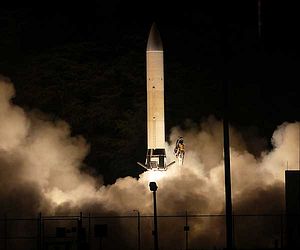Russia will build its first hypersonic missile by 2020, according to local state media.
On Thursday Sputnik News Agency, RIA Novosti’s new international brand, cited a senior official at a state-owned Russian defense company as saying that Russia would build its first air-launched hypersonic missiles before 2020.
“In my estimation, the first hypersonic products should appear … in this decade — before 2020. We have approached this. We are talking about speeds of up to six to eight Mach. Achieving higher speeds is a long term perspective,” Sputnik quoted Boris Obnosov, general director of the Tactical Missile Systems Corporation, as saying on Thursday.
He made the remarks to journalists at the Zhuhai’s Air Show in China this week.
Also citing Obnosov, the report added that Russia’s “hypersonic missiles will be air-launched at first, using the carrier aircraft’s initial velocity to reach the speeds necessary to run a ramjet engine.”
Previously, Obnosov has said that Russia would test its first hypersonic missile by 2020.
Tactical Missile Systems is a state-owned defense company in Russia focusing on missiles that was established by a presidential decree in 2004. According to the Moscow Times, the company produces much of the guided missile systems for Russia’s Defense Ministry.
The target date of 2020 is significant because that is the year Russia intends to complete its military modernization program. In 2010 Russia announced it would spend around $600 billion over the next decade to modernize its armed forces with more high tech weaponry.
Russia is also jointly developing the Brahmos-II hypersonic cruise missile with India. An official at Brahmos Aerospace — the joint venture between India’s Defense Research and Development Organization (DRDO) and Russia — told The Hindu earlier this year that “a preliminary design [of Brahmos-II] is being done in the lab and the complete missile may take nearly five years to fructify.” However, in 2012 Indian officials also projected the hypersonic missile would be ready in five years time.
The United States and China are also busy developing hypersonic missiles, in what some have already dubbed a hypersonic arms race. The U.S. last tried to test a hypersonic missile back in August. That test failed when the rockets exploded four seconds after launch.
China is also believed to have tried to test a hypersonic glide vehicle (HGV), the Wu-14, two times in the past, most recently in August. That test also failed.
Both nations had previously carried out successful tests of some of their boost glide systems.
Hypersonic missiles travel at five times the speed of sound (3,840 miles per hour) or more using boost-glide rockets that differentiate their trajectory from ballistic missiles, which typically carry nuclear warheads. As James Acton, a senior associate at the Carnegie Endowment, explains of hypersonic missile trajectories, “rather than arcing higher than the atmosphere [as ballistic missiles do], they are put on a trajectory to reenter the atmosphere as quickly as possible. Then they just glide to the target.”
This trajectory makes them difficult to target using current missile-defense systems.

































